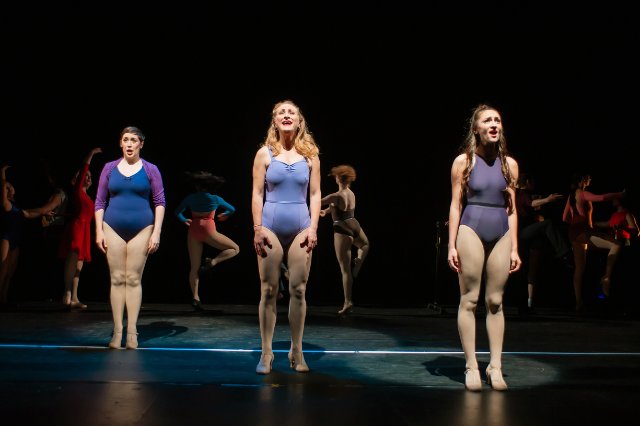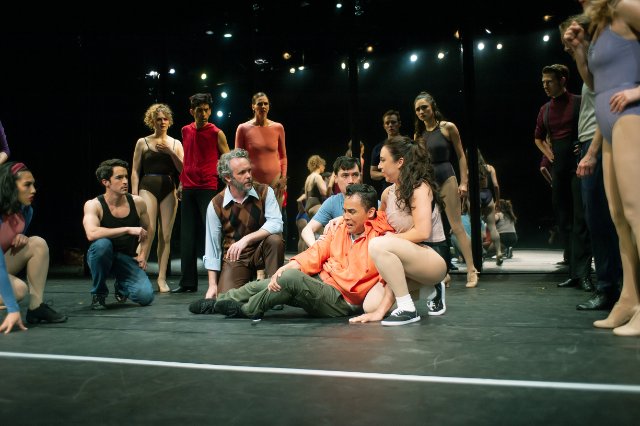A Chorus Line
Character Laid Bare in the Pursuit of Dreams.
By: Victor Cordell - Jul 06, 2023
On Broadway and in Hollywood, the backstage genre endures and endears like few others. They vary wildly in their treatment of the people and processes involved in putting a production on stage or screen, from “42nd Street” to “All About Eve” and from “Noises Off” to “Summer Stock.” But in the history of American entertainment, no backstage montage has proven more heart wrenching and more diverse in its themes explored and its characters examined than “A Chorus Line.” There are many good reasons why it is one of the most successful Broadway musicals of all time and why it is often revived the world over. San Francisco Playhouse has captured the fairy dust magic of this very special entertainment.
Anxiety, uncertainty, and rejection fill the life of a would-be stage dancer. “A Chorus Line” hits its mark from the opening beat. The first memorable numbers typify the thoughts of the eager auditioners and propel the subtext. Lyrics like “I hope I get it,” “I really blew it,” “I’ll never make it,” and “I really need this job” express the toll taken in precise terms.
Auditions are demeaning and choreographers are heartless in the grueling operation of winnowing down an abundance of candidates to a chorus line that will be contracted for a show. But this musical’s creator as well as original director and choreographer, Michael Bennett, built on recorded interviews of dancers to devise the concept of having the final 16 competitors aligned on the stage to talk about themselves and what brought them to dancing.
The result is one catharsis after another that engages the audience emotionally like few other dramas. Each performer has different motivation, aspiration, and expectation. Most have dark stories to tell - nonacceptance, loneliness, and abuse are common themes.
Humor is found in the background of many of the “gypsies.” One character, Bobby, is modeled after Bennett, who, being from Buffalo, is no doubt responsible for Bobby’s line “committing suicide in Buffalo is redundant.” Judy complains of being too tall, while Connie laments being too short. Kristine is tone deaf. Val suffered from not having noticeable tits. And Paul, based on co-writer Nicholas Dante, had to hide from his parents the fact that he was playing stage parts in drag. These and all the stories are told with great conviction and the appropriate emotion.
The puppetmaster/inquisitor, also known as the choreographer, is Zach, deftly portrayed by Keith Pinto. An unseen voice at the back of the audience while interviewing the dancers, he demonstrates both his dancing skills and acting chops when on stage. Some of his big moments are his one-on-ones with Cassie, played by talented triple-threat cast alternate Adria Swan (the role is mostly played by choreographer Nicole Helfer). Near invisible in the first act, she emerges to be the female lead. She is a special case. Not only has she been a featured dancer, but she has a history with Zach, and the dynamics of history will add to the friction in the narrative.
This production engages and entertains throughout. Some artists sing better; others dance better; and all are expected to act a bit. So a little unevenness in overall performances is understandable, but at no time does that detract from the appreciation. Bill English’s direction is seamless, and Helfer’s choreography sparkles. Interestingly, it is hard at times to tell whether the lack of synchronization is because the dancers aren’t up to snuff, or because Helfer has adopted Bennett’s seminal notion that the dancers shouldn’t be totally in sync because they are in auditions, not performances. We’ll accept the latter. Notwithstanding, the rousing, high-kick finale to the dancer’s anthem song “One” was excellent and exacting and not expected given the wild range of heights and girths of the performers. The rising excitement from the audience through the number was palpable.
But if “One” provides a rousing and uplifting finish, it is the penultimate number that lingers. The signature “What I did for love” is a hauntingly beautiful song that also encapsulates what it is to be an aspiring hoofer – drawn compulsively to the beauty of expression; knowing that the likelihood of success is low; and that even success in dance is ephemeral. So “kiss today goodbye, and point me toward tomorrow…..the gift was ours to borrow…..won’t forget, can’t regret, what I did for love.”
“A Chorus Line,” conceived by Michael Bennett, book by James Kirkwood and Nicholas Dante, music by Marvin Hamlisch, and lyrics by Edward Kleban, is produced by San Francisco Playhouse and performed on its stage at 450 Post Street, San Francisco, CA through September 9, 2023.






